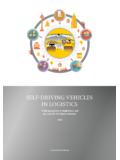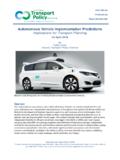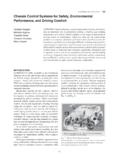Transcription of Guideline for Developing National Internet of …
1 Appendix: Guideline for Developing National Internet of Vehicles Industry Standard System (Intelligent & Connected Vehicle). (2018). December 2017. Released by Ministry of Industry and Information Technology of the People's Republic of China and Standardization Administration of the People's Republic of China Contents I. Overall requirements .. - 2 - (I) Guiding - 2 - (II) Basic principles .. - 2 - (III) Development goals .. - 2 - II. Development method .. - 3 - (I) Technical logic structure .. - 3 - (II) The physical structure of the product .. - 4 - III. Standard system .. - 5 - (I) System framework .. - 5 - (II) Content of the system .. - 6 - (III) Near-term plan .. - 8 - IV. Organization and implementation .. - 10 - Appendix:ICV Standard System .. - 12 - Guideline for DevelopingNational Internet of Vehicles Industry Standard System (Intelligent & Connected Vehicle 2018). Foreword In order to strengthen the top-level design and comprehensively promote the Internet of Vehicles industry research and development and standards formulation to promote the healthy and sustainable development of the industry, the Ministry of Industry and Information Technology and Standardization Administration of jointly organized relevant parties to develop the Guideline for Developing National Internet of Vehicles Industry Standard System ( hereinafter referred to as the Construction Guide ).
2 The Internet of Vehicles industry is an emerging industry that deeply integrates the automotive, electronics, information & communications, road transportation and other industries. It is the highlight and stronghold of the global innovation and future development. By fully playing the top - level design and guiding role of standards in establishing the eco - system of the Internet of vehicles industry, the Construction Guide is divided into the intelligent and connected vehicle standard system, information & communication standard system, electronic product & service standards system and other parts according to the characteristics of different industries, with a view to providing support for building independent, well - controlled, open and collaborative Internet of Vehicles industry with core technologies. A Guide to the Construction of the National Standard System for Internet of Vehicles (Intelligent Connected Vehicles) is the second part of the Construction Guide , it's released to define the general specifications, core technologies and key product applications of intelligent & connected vehicles, with a view to guiding the standardization of Internet of Vehicles industry and intelligent and connected vehicles with good purposes, plans and priorities, to efficiently Developing intelligent & connected vehicle standard system that integrates functional safety and information safety of vehicle and key systems & components, giving full play to the supporting and leading role of intelligent & connected vehicle standards in the key technology, core products and functional applications of Internet of Vehicles industry, and gradually forming a unified and coordinated architecture of National Internet of Vehicles industry standard system.
3 (This file is translated by Subcommittee 34 on Intelligent and Connected Vehicle of National Technical Committee 114 on Road Vehicles of Standardization Administration of China (SAC/TC114/SC34). It should be subject to the Chinese Edition, while the English edition is just only offered for the reference.). Intelligent and Connected Vehicle of National Technical Committee 114 on RoadVehicles of Standardization Administration of China -1- (SAC/TC114/SC34). 1. Guideline for DevelopingNational Internet of Vehicles Industry Standard System (Intelligent & Connected Vehicle 2018). I. Overall requirements (I) Guiding concept We will implement the strategic planning of Made in China 2025 , give full play to the basic and guiding role of the standards, promote the technological and industrial development of intelligent & connected vehicles, and achieve high integration of industrialization and information, so as to meet the needs of R & D, testing, demonstration and operation, to promote the automotive technology innovation & development and industrial transformation and upgrading, to promote the coordinated development of electronic, information, communications and other related industries, to construct a safe, efficient, healthy and intelligent future automotive society, and to establish cross-industry and cross - sector ICV standard system that is consistent with China's technological and industrial development.
4 (II) Basic principles Conduct overall planning based on National conditions. Based on the status quo and characteristics of China's ICV technological and industrial development, we should give full play to the leading role of government departments in the top design, organization & coordination and policy development and other aspects, develop the standard system development program based on government guidance and market drive, and establish of the ICV standard system that adapts to China's National conditions. Basic and urgent agenda shall be prioritized. We should identify the priorities for Developing ICV standard system, speed up the research and development of basic, common and key technical standards; we should also make reasonable arrangements in Developing and revising technical standards based on current industrial development and future application needs, and speed up the process of researching and Developing the standards in urgent need. Enterprises should play the major role to promote coordinated cooperation.
5 We should establish the collaborative working mechanism across different industries, sectors and departments, make coordinated use of advantageous resources in automotive information, communications and other related industries, help the enterprises to play the major role in researching and Developing the standards in technological innovation, product development, demonstration and application, and actively participate in the coordination, exchange and cooperation of international standards and regulations. (III) Development goals According to the status quo of ICV technology, industrial application needs and future development trend, we strive to establish an ICV standard system that adapts to China's National conditions and international practices: By 2020, we should roughly establish the ICV standard system that can support the driver assistance and low - level automatic driving . We should develop more than 30 key ICV standards that cover the technical requirements and test methods related to general technologies such as functional safety, information security and man - machine interface, etc.
6 As well as core functions such as Information sensing & interaction, decision early warning, auxiliary control, and promote comprehensive application of intelligent products and gradual application of network technology;. By 2025, we should establish a sound ICV standard system that can support high - level automatic driving . We should develop more than 100 ICV standards that cover the technical requirements and test methods related to the function and performance of intelligent automatic control, network collaborative decision technology and automatic driving under typical scenes, and promote intelligent + network - based integrative development and comprehensive application of technologies and products;. Intelligent and Connected Vehicle of National Technical Committee 114 on RoadVehicles of Standardization Administration of China -2- (SAC/TC114/SC34). 2. Guideline for DevelopingNational Internet of Vehicles Industry Standard System (Intelligent & Connected Vehicle 2018). By establishing a sound ICV standard system, we should guide and promote technological development and product applications of intelligent network vehicles in China, cultivate the climate for independent innovation of ICV technology, enhance the overall technology level and international competitiveness, and build a safe, efficient, healthy and intelligently running future automotive society.
7 II. Development method Intelligent network vehicles are new - generation cars that are equipped with advanced vehicle sensors, controllers, actuators and other devices. By integrating modern communications and network technology, they can exchange and share intelligent information between the car and X ( people, cars, roads, cloud terminals, etc. ). They boast environmental awareness, intelligent decision, collaborative control and other functions, can achieve safe, efficient, comfortable and energy - saving driving , and ultimately realize automatic operation in lieu of people. To build a scientific and rational ICV standard system, we should take full account of the basic situation in different dimensions and sort out the development methods: embrace future technology and avoid causing constraints on technological innovation and industrial development; prioritize intelligence roadmap while also considering the network roadmap; meet China's road & traffic characteristics and industrial needs based on China's basic conditions; conduct scientific classification and define rational hierarchy, positioning and applicable scope; develop the work schedule and speed up the development and revision of standards in urgent need; strengthen systematic coordination to achieve compatibility with other relevant industry standards; keep open-minded to actively participate in the development and coordination of international standards and regulations.
8 By fully considering the above-mentioned ideas, we should focus on the system analysis from the perspective of technical logic structure and physical product structure, analyze the basic characteristics of ICV technology and products, and construct the whole standard system. (I) Technical logic structure The two main lines of technical logics of Intelligent Connected Vehicles (ICV) are "information perception". and "decision control". The core of the development for ICV technology is to gradually replace the driver's actual operation with system-based information perception, early warning decision and intelligent control, finally realizing completely autonomous operation of vehicles (as shown in Figure 1). According to the ICV. Technology Roadmap , ICV can be classified into two categories, , intelligence - oriented and network - oriented; ICV helps achieve "information perception" and "decision control" functions through the two technical paths of intelligence and networking. Intelligent and Connected Vehicle of National Technical Committee 114 on RoadVehicles of Standardization Administration of China -3- (SAC/TC114/SC34).
9 3. Guideline for DevelopingNational Internet of Vehicles Industry Standard System (Intelligent & Connected Vehicle 2018). Onboard entertainment Non- driving related Onboard Internet information Information perception Self-detection Sensing & detection Information driving related exchange Decision warning Horizontal control Driver Driver assistance (DA). Horizontal or longitudinal control Assist control Longitudinal Human-monitored control driving environment Partial automation (PA). Horizontal or longitudinal control Decision control Conditional automation (CA). Specific conditions, partial tasks Natural control High automation (HA). System-monitored Specific conditions, all tasks driving environment Full automation (FA). All conditions, all tasks Figure 1 Logic structure of ICV technology Based on the influence of information on driving behavior and mutual relationship, information can be divided into driving -related information and non - driving related information . Among them, " driving related information" includes sensing detection information and decision warning information.
10 Non - driving related information" mainly includes onboard entertainment services and onboard Internet information services. According to the way that information is obtained, the sensing detection information can be further divided into information obtained by relying on the vehicle's own sensor ( self-detection ) and information that the vehicle itself receives from other external nodes through the vehicle - mounted communication device ( information exchange ) . The combination of intelligence-oriented and network oriented can make the vehicle perceive the environment more comprehensively through information interaction with the external nodes on the basic of direct detection by its own sensors, so as to better support the vehicle decision and control. According to the role and responsibilities of vehicle and driver in the vehicle control, the control can be divided into assist control and automatic control that correspond to different levels of intelligent control. Among them, the assist control mainly means that the vehicle uses various types of electronic technology to assist the driver for vehicle control, such as horizontal control and/or longitudinal control.








